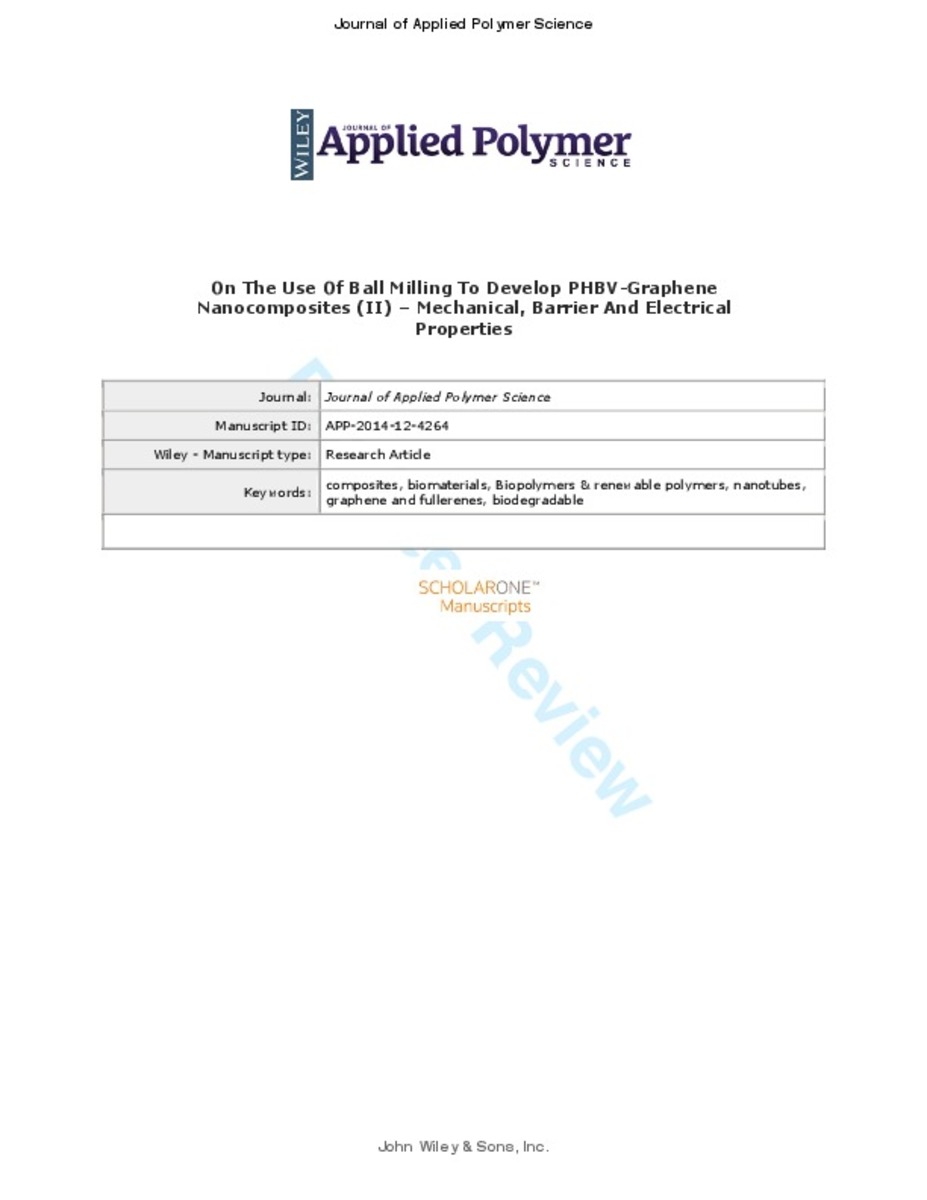Mostrar el registro sencillo del ítem
On the use of ball milling to develop poly(3-hydroxybutyrate-co-3-hydroxyvalerate)-graphene nanocomposites (II)—Mechanical, barrier, and electrical properties
| dc.contributor.author | Ambrosio Martín, Jesús | |
| dc.contributor.author | Gorrasi, Giuliana | |
| dc.contributor.author | López Rubio, Amparo | |
| dc.contributor.author | Fabra, María José | |
| dc.contributor.author | Cabedo, Luis | |
| dc.contributor.author | López Manchado, Miguel Angel | |
| dc.contributor.author | LAGARON, Jose | |
| dc.date.accessioned | 2016-05-06T09:18:47Z | |
| dc.date.available | 2016-05-06T09:18:47Z | |
| dc.date.issued | 2015-04 | |
| dc.identifier.citation | AMBROSIO‐MARTÍN, Jesús, et al. On the use of ball milling to develop PHBV–graphene nanocomposites (II)— Mechanical, barrier, and electrical properties. Journal of Applied Polymer Science, 2015, 132.29. | ca_CA |
| dc.identifier.uri | http://hdl.handle.net/10234/159349 | |
| dc.description.abstract | In this work, poly (3-hydroxybutyrate-co-3-hydroxyvalerate) (PHBV) nanocomposites containing functionalized graphene sheets (FGS) were prepared by means of high-energy ball milling. The crystalline structure, oxygen barrier, mechanical and electrical properties, and biodegradability of the developed nanocomposites were analyzed and correlated with the amount of FGS incorporated and with their morphology, which was reported in a previous study. Addition of FGS into the PHBV matrix did not affect the crystal morphology of the material but led to somewhat enhanced crystallinity. The good dispersion and distribution of the nanofiller within the polymeric matrix, revealed in the first part of this study, was thought to be crucial for the mechanical reinforcing effect of FGS and also resulted in enhanced gas barrier properties at high relative humidity. Additionally, the conducting behavior of the nanocomposites, as interpreted by the percolation theory, displayed a very low percolation threshold set at ∼0.3 vol % of FGS, while the materials exhibited an overall significantly enhanced conductivity. | ca_CA |
| dc.description.sponsorShip | J. Ambrosio-Martín would like to thank the Spanish Ministry of Economy and Competitiveness for the FPI grant BES-2010-038203. M.J. Fabra is recipient of a “Juan de la Cierva” contract from the Spanish Ministry of Economy and Competitiveness. The authors acknowledge financial support from the MINECO (MAT2012- 38947-C02-01 project) and the EU FP7 ECOBIOCAP project. | ca_CA |
| dc.format.extent | 35 p. | ca_CA |
| dc.format.mimetype | application/pdf | ca_CA |
| dc.language.iso | eng | ca_CA |
| dc.publisher | © 2015 Wiley Periodicals, Inc. | ca_CA |
| dc.relation.isPartOf | Journal of Applied Polymer Science, Volume 132, Issue 29, August 5, 2015 | ca_CA |
| dc.rights | Copyright © 2016 John Wiley & Sons, Inc. All Rights Reserved | ca_CA |
| dc.rights.uri | http://rightsstatements.org/vocab/InC/1.0/ | * |
| dc.subject | biopolymers & renewable polymers | ca_CA |
| dc.subject | blends | ca_CA |
| dc.subject | graphene and fullerenes | ca_CA |
| dc.title | On the use of ball milling to develop poly(3-hydroxybutyrate-co-3-hydroxyvalerate)-graphene nanocomposites (II)—Mechanical, barrier, and electrical properties | ca_CA |
| dc.type | info:eu-repo/semantics/article | ca_CA |
| dc.identifier.doi | 10.1002/app.42217 | |
| dc.rights.accessRights | info:eu-repo/semantics/openAccess | ca_CA |
| dc.relation.publisherVersion | http://onlinelibrary.wiley.com/wol1/doi/10.1002/app.42217/full | ca_CA |
Ficheros en el ítem
Este ítem aparece en la(s) siguiente(s) colección(ones)
-
ESID_Articles [468]







